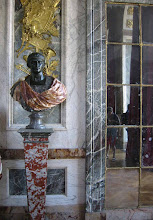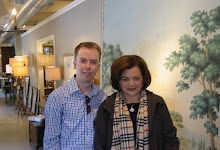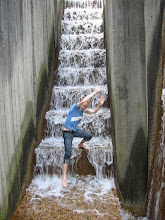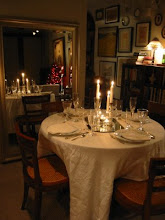 Henry Hobson Richardson (1838-1886) one of the most prominent architects of the 19th century. He left an important mark not only on our country's cities, but also on the architectural styles of the world. Much of the work he created late in his career is in Pittsburgh.
Henry Hobson Richardson (1838-1886) one of the most prominent architects of the 19th century. He left an important mark not only on our country's cities, but also on the architectural styles of the world. Much of the work he created late in his career is in Pittsburgh. Most well known is the Allegheny Courthouse & Jail (1883-1886). Richardson died before its completion (at age 47 of kidney failure) but considered this his finest work and a culmination of his lifes' work. Built of huge chunks of gray granite (some pieces weighing up to 5 tons!), in 2007 the AIA named it the 35th favorite building in the country. Sure, not in the top 5 but this was NATIONALLY -so thats pretty high considering the millions of buildings to chose from!
Most well known is the Allegheny Courthouse & Jail (1883-1886). Richardson died before its completion (at age 47 of kidney failure) but considered this his finest work and a culmination of his lifes' work. Built of huge chunks of gray granite (some pieces weighing up to 5 tons!), in 2007 the AIA named it the 35th favorite building in the country. Sure, not in the top 5 but this was NATIONALLY -so thats pretty high considering the millions of buildings to chose from! Notice anything odd in this photo above? You can see the line where the original grade or ground was when the building was built. This was initially built on a hill downtown which was later removed to create flat streets for streetcars and ease of traffic. So for many buildings, the former basement became the first floor! Hence all the stairs going up to the main level.
Notice anything odd in this photo above? You can see the line where the original grade or ground was when the building was built. This was initially built on a hill downtown which was later removed to create flat streets for streetcars and ease of traffic. So for many buildings, the former basement became the first floor! Hence all the stairs going up to the main level.  You can see this below in the entrance to the courtyard above as well. See the tiny windows on the first floor? They're almost like portals!
You can see this below in the entrance to the courtyard above as well. See the tiny windows on the first floor? They're almost like portals! The beautiful interior courtyard. The fountain is original.
The beautiful interior courtyard. The fountain is original.
The term for the style 'Richardsonian Romanesque' was coined to describe the heavy, rusticated stone buildings he was known for: with square byzantine columns supporting arched openings, , symmetry and clear beaux arts planning, occasional gothic elements and often a French Renaissance influence. Thats a whole lot going on! He was the 2nd American Architect to study at the Ecole des Beaux Arts in Paris (after William Morris Hunt, whom I blogged about in a 4 part series back in February. You can read the first of these posts HERE). 

 The interior stairway is especially grand -fitting for a public building of justice.
The interior stairway is especially grand -fitting for a public building of justice.
These beautiful frescos decorate the main lobby.

 The interior stairway is especially grand -fitting for a public building of justice.
The interior stairway is especially grand -fitting for a public building of justice.
 The entrance to the old law library is especially grand. The scale is so huge as to make it seem almost modern.
The entrance to the old law library is especially grand. The scale is so huge as to make it seem almost modern. If this structure below, the jail, looks familiar, it's because it was used in "The Silence of the Lambs" for the jailhouse scenes.
If this structure below, the jail, looks familiar, it's because it was used in "The Silence of the Lambs" for the jailhouse scenes. 
 This bridge which cleverly connects the courthouse to the old jail (seen above) was modeled after 'the bridge of sighs' in Venice. Easy commute to your prison cell from the courtroom! Interesting fact, Pittsburgh has the most bridges of any city in the world second to Venice.
This bridge which cleverly connects the courthouse to the old jail (seen above) was modeled after 'the bridge of sighs' in Venice. Easy commute to your prison cell from the courtroom! Interesting fact, Pittsburgh has the most bridges of any city in the world second to Venice. front facade of Emmanual Episcopal church
front facade of Emmanual Episcopal churchLess well known, but very unusual for his work and this time period is the Emmanual Episcopal church in the Allegheny West neighborhood I mentioned yetserday. Built in 1884, it was created a national historic landmark in the year 2000.  The exterior is extremely simple with a gabled front but with an extermely unusual rounded nave. Richardson used arches here even in plan!
The exterior is extremely simple with a gabled front but with an extermely unusual rounded nave. Richardson used arches here even in plan!  the facade above is the left hand side of this picture, you can see it curving to the right.
the facade above is the left hand side of this picture, you can see it curving to the right.
 The exterior is extremely simple with a gabled front but with an extermely unusual rounded nave. Richardson used arches here even in plan!
The exterior is extremely simple with a gabled front but with an extermely unusual rounded nave. Richardson used arches here even in plan!  the facade above is the left hand side of this picture, you can see it curving to the right.
the facade above is the left hand side of this picture, you can see it curving to the right.
This is a view of the back of the building facing the alley. You can see how a future architect put an addition on - he met curve with more curve!
Because of the simplicity, it was way ahead of its time and hinted at the modernity to come. look at this intricate brickwork at the front arches
look at this intricate brickwork at the front arches
 this side gate into a courtyard with parsonage was added later, but i just thought it was so pretty that I had to post it!
this side gate into a courtyard with parsonage was added later, but i just thought it was so pretty that I had to post it!
 look at this intricate brickwork at the front arches
look at this intricate brickwork at the front arches this side gate into a courtyard with parsonage was added later, but i just thought it was so pretty that I had to post it!
this side gate into a courtyard with parsonage was added later, but i just thought it was so pretty that I had to post it!You see examples and copies of this style all over the country, it was so popular. Even in this neighborhood, Allegheny West, are many examples of Richardsonian Romanesque, probably not by Richardson (but who knows!). I saved the best for last, some beautiful houses!

 This one is richardsonian too! I've been inside on a housetour, it's positively spooky and Victorian inside!
This one is richardsonian too! I've been inside on a housetour, it's positively spooky and Victorian inside! I've been inside this home as well, it's beautiful and very Victorian with heavy atmosphere with lots of curiosities.
I've been inside this home as well, it's beautiful and very Victorian with heavy atmosphere with lots of curiosities. I love how this old stone ages
I love how this old stone ages I just wanted to post this front door with wreaths!
I just wanted to post this front door with wreaths! Lastly, this house isn't really Richardsonian Romanesque, but you can clearly see the influence in the rusticated stone and arched windows. I post this house last to pique your interest -it also had a very famous inhabitant that I'll blog about later this week!!
Lastly, this house isn't really Richardsonian Romanesque, but you can clearly see the influence in the rusticated stone and arched windows. I post this house last to pique your interest -it also had a very famous inhabitant that I'll blog about later this week!!


















.jpg)






















.JPG)








































































16 comments:
I once sketched the the Venice 'bridge of sighs' from a travel magazine...didn't know the story behind it...
Great post...love the gothic arches.
Michelle
Oh, wow, another amazing post! Your photos are wonderful, especially that magnificent first interior shot. You know, we have a large building downtown Columbus that is constructed from that bumpy looking grey granite. I wonder if it is a Richardson? I must find out.
Thanks for the Pittsburgh tour. I used to live there and have fond memories of the old tree-lined streets with interesting architectural time-capsules.
Thanks for sharing. Love the arches- we just finished building my dad's house & put archways throughout.
some chianti with this post please...
is the Allegheny Courthouse & Jail where they filmed 'silence of the lambs' ?
it reminds me of the place that they kept 'hanibal' .
no ?
the set back walls makes all the difference in the world !
Richardson's work is so old world, it reminds me of england.
xx
Thanks everyone!
Renee, yes, this jail was used for 'silence of the lambs' - spooky!
Willow - there were many copies built of his work, which is why the style was made 'richardsonian romanesque' - a lot of libraries, courthouses and jailes from this time period look similar! If it was a richardson building, it will probably have a plaque. Let me know, I would love to see pictures!
Athens - the city has fabulous architecture and so much history. I'll always consider it home and I love visiting!
S-
did you get my mail ?
and about now, I will have the chianti
xx
This post is positively haunting - the mystery and intrigue are all fascinating.
You would make a great tour guide! ( You already have shown me so many incredible places!)
I am a huge fan of H.H. Richardson's work, and Beaux Arts makes me SWOON.
I thought that was the same jail. Gives me the shivers just thinking about it.
Your blog is a constant joy to read. It was my dream to be an architect, but at the time, I had a weird form of dyslexia with numbers which I've learn to overcome, but limited me then. I drew buildings from age 4 on.
You have the best job in the world, you know that....right? :-)
Note the similarities in our city county building,
seen here:
http://farm3.static.flickr.com/2223/2120819973_e74538b1f2.jpg
Patricia, thanks so much! A tour guide would be a really fun job!!
Halcyon - i love my job more than anything. I feel very lucky to do what I love everyday!
Derek, they are pretty similar! Thats a more fantastical and elaborate version of it for sure! It was so popular that it was copied many places -you just found one :-)
wonderful images and very interesting post, thanks!
This was a fabulous post! I did not know that later the ground was removed to create more room for streets. I thought it was for flooding issues, etc. Thanks for the great lesson.
Great post. I'm smarter tonight because of you. Thank you for taking the time to share your knowledge. Oh, and I remembered wondering where that building was located in Silence of the lambs when I watched the movie...now I know.
beautiful... Romanesque doesn't get enough love as far as I'm concerned!
Here is the Richardsonian Romanesque High School in Duluth Minnesota. You can follow the links in the post to the Minneapolis Municipal Building and the Masonic Temple, also by Long and Kees. After all these years of looking at these buildings (I became a big fan in the early 80s because of an exhibit I designed on the courthouse history I am beginning to see a gestalt in this style that is truly an American pastiche style. At first glance it does look like an anachronistic emulation of the Romanesque, but as you have pointed out, the steep foors and gables and decorative stone interpretations reveal the over all style to be an imaginative reworking of the traditions, not just a slavish copy. If you know of a critic or commentator who has developed this idea out I would love to read it. Your insights have been quite valuable to me. Thanks.
Post a Comment